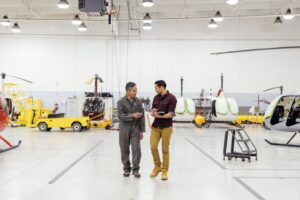
Optimize and innovate: How digital twins transform manufacturing
Digital twin technology was pioneered at NASA, to monitor and operate complex systems in very remote, critically hazardous conditions. The ability to record real-time telemetry data and process it into modeled simulations quickly proved valuable in other remote, demanding, or dangerous industrial processes.
But things don’t have to be big and scary for costly downtime or for inefficient design processes to affect your bottom line. Today, almost any manufacturer can collect production data from sensor-enabled and IoT-connected machines and devices, combine it with cloud-based machine learning and familiar CAD visualization systems, and apply digital twin technology to a wide range of products, production assets, and processes.
Value for every manufacturer
Imagine a digital twin as a virtual replica of a manufacturing asset—a finished product, a process, a factory robot—in its productive environment. With data collected from the asset and its environment under multiple performance conditions, you can model the replica into 3D virtualizations to maintain, troubleshoot, and repair equipment; validate design or process innovation; or audit product quality.
We believe that almost any manufacturer can use a digital twin, and that the ability to create, build, test, and validate in a data-fed virtual environment will be a significant competitive differentiator in the next two to three years. Maybe that’s why Gartner named digital twin one of the top 10 strategic technology trends for 2017.*
Quick benefits
You can reduce production costs and downtime by using a digital twin to triage breakdowns or maintenance events—or just eliminate problems before they occur. You’ll avoid catastrophic failures and have more operational flexibility. Say your monitoring system predicts an imminent pump clog or failure, but you can’t get the replacement part or afford the downtime. Digital twin simulations provide you options to adjust performance or safely postpone the maintenance based on a quantitative analysis of the financial impacts.
Designers and engineers live for the big breakthroughs, but most innovation cycles are about incremental improvement. You can use digital twin virtualizations to develop insights about how existing equipment, processes, or products perform over time; use the information to influence and validate new prototypes; and bring better products to market faster, at less cost. That makes the real breakthroughs more achievable, more cost-effective, and better aligned with the full product life cycle.
A holistic approach
Your business has been collecting production data and using CAD and other visualization systems for a long time. Now you can use the power of cloud-based analytics to turn those existing assets into tools that help you optimize processes, save money, and accelerate innovation.
At Microsoft Services, we believe manufacturers can use a holistic approach to digital twin services that includes strategic planning, deployment, and adoption. We can help you define the digital twin scenarios that will have the biggest impact on your manufacturing business.
* Gartner, Smarter with Gartner, Gartner’s Top 10 Strategic Technology Trends for 2017, http://www.gartner.com/smarterwithgartner/gartners-top-10-technology-trends-2017/
Learn how to transform manufacturing
with Microsoft Services




